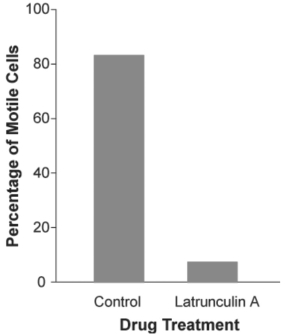Figure 29.3
Use the following information when answering the corresponding question(s) .
The mechanism of cell crawling in protist species is not well defined.The textbook states that pseudopodia extension involves interactions between actin and myosin (the same molecules that are involved in mammalian muscle contraction) .However,prior to the study described below,no one had provided convincing data that actin and myosin were actually involved in cell crawling in protists.Anatomical studies had identified the cytoskeletal protein actin just below the surface of the cell membrane in several species of protist;but physiological studies had failed to show a functional link between actin,myosin,and cell crawling.
In a study by N.Poulsen et al.(Diatom gliding is the result of an actin-myosin motility system,Cell Motility and the Cytoskeleton 44 (1999) :23-22) ,researchers tested whether motility in a particular species of diatom involves interactions between actin and myosin.

-Refer to the study by Poulsen et al.and Figure 29.3.Latrunculin A is a reversible toxin that disrupts the formation of actin fibers.A culture of a particular species of diatom was treated with this toxin diluted in a buffer,while another culture was treated only with the buffer (no toxin;control) .The motility of cells in each culture was assessed by counting the number of cells that were moving during a defined period of time.Which of the following conclusion statements is reasonable based on the above figure?
Definitions:
Q1: The body cavity type for arthropods and
Q13: What is present in a shoot apical
Q16: Plant embryos do not undergo the developmental
Q18: Animal rights activists often say that all
Q20: The snake family Typhlopidae consists of small,burrowing
Q25: The protein of the bicoid gene in
Q26: Imagine that you are given some chemoorganotrophic
Q26: Referring to Simard et al.(1997),which design element
Q33: Which of the following statements best describes
Q45: Which of the following adult animals might